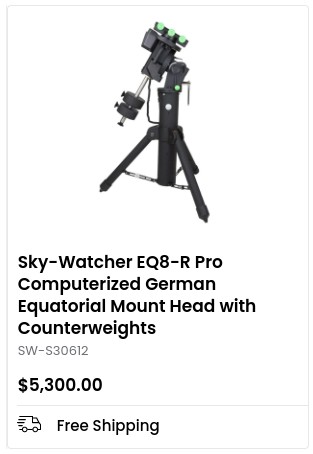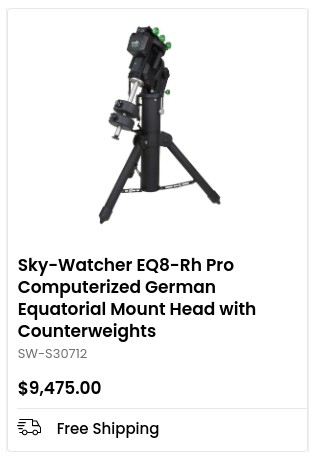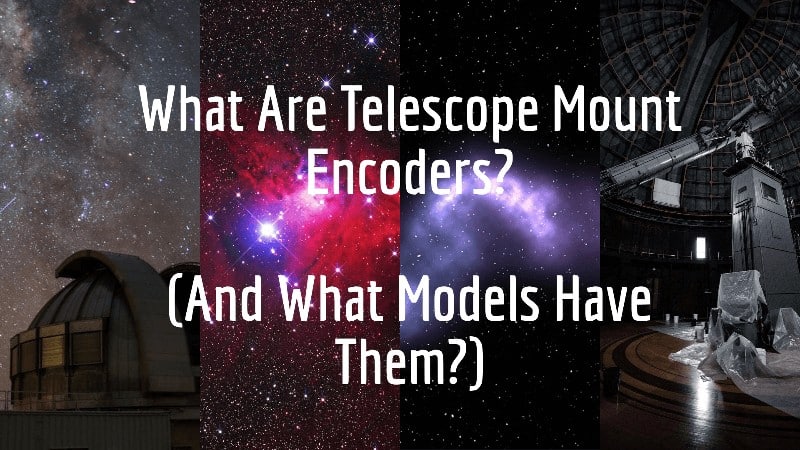You may have seen telescope mounts boast that they are with encoders or absolute encoders.
But what does this mean and is it something you need?
In this article we are going to investigate and try and answer the questions:
- What are encoders?
- What does it mean when a mount has encoders?
- Which mounts have encoders?
- Do you need a mount with encoders?

What Are Encoders?
- Encoders are devices used in engineering that precisely measure position and movement, as well as speed and direction.
- They turn this into electronic data down to an extremely small measurement.
- This data is received by a control device so that it knows exactly where the encoder is to the tiniest measurement.
- They can be used in a wide range of industries like aerospace, robotics, and medical equipment, for example in things like wind turbines or 3D printers.
We are not going to go too much deeper into this as we are an astronomy and astrophotography website and not an engineering one, but if you want to know more about encoders in general then I recommend watching this video:
What Are Encoders on a Telescope Mount?
Taking this knowledge about what an encoder is, there is a fairly obvious application to telescope mounts – encoders allow mounts to ensure that the telescope is pointing exactly where you want it for long periods, with an extremely high degree of precision.
Encoders are attached to the mount’s RA (right ascension) axis or both RA and DEC (declination) axes and measure the position and movement as it tracks objects in the night sky.
To explain:
- Electronic computerized/GOTO telescope mounts find and track objects in the night sky so that you can view and photograph them over longer periods.
- Therefore they should know exactly where the telescope is pointing so that it stays precisely on the target (the astronomical object).
- The problem with this is that things like periodic errors and backlash occur in mounts with gears. This reduces the precision of the tracking and so they lose a degree of accuracy that, in particular, can impact long exposure deep sky imaging.
- A mount using an absolute encoder will automatically compensate for any errors, allowing for extremely precise tracking.
Techniques such as guiding can also compensate for tracking errors but mounts with encoders provide a solution that doesn’t require additional gear and management.
Dylan O’Donnell has a good video on mounts with encoders that’s worth a watch:
Advantages and Disadvantages of Encoders in Mounts
It’s pretty clear then that the advantage of encoders in mounts is improved tracking, but are there any downsides?
In short, the answer is yes, and that’s cost.
Encoder devices cost thousands of dollars and so when these are incorporated into mounts the price goes up accordingly.
In the images below you can see the cost (at the time of writing) for the Sky-Watcher EQ8-R Pro and Sky-Watcher EQ8-Rh Pro mounts.
These are identical mount except that the EQ8-Rh model is fitted with encoders:


What Mounts Have Absolute Encoders?
Telescope mounts with absolute encoders that are available to buy are:
- Skywatcher EQ8Rh-Pro
- Software Bisque Paramount ME II
- Software Bisque Paramount Taurus 400
- Astro-Physics 1100GTO
- Astro-Physics 1600GTO
- Astro-Physics Mach2GTO
- iOptron CEM40EC
- iOptron GEM45EC
- iOptron CEM70EC
- iOptron CEM120EC
- iOptron CEM120EC 2
- 10 Micron GM1000 HPS
- 10 Micron GM2000 HPS II
- 10 Micron GM3000 HPS
- 10 Micron GM4000 HPS II
- 10 Micron AZ1000 HPS
- 10 Micron AZ2000 HPS
- 10 Micron AZ3000 HPS
- 10 Micron AZ4000 HPS
- ASA DDM100
- ASA DDM200
- ASA DDM500
These are all high end, premium mounts costing up to $100,000 in some cases, like the ASA DDM500.
The cheapest mount with encoders that I can find is the iOptron CEM40 EC for around $4500.
Encoders FAQs:
What are incremental vs absolute encoders?
There are two main types of encoders:
- Absolute encoders that measure position. They provide an exact digital measurement that can be defined and maintained even if the device has moved. For example, if a gust of wind moves a mount then the absolute encoder will detect it and restore its position.
- Incremental encoders that measure movement. They do not provide data on the actual position, only that it has changed and derive position from this. Therefore they would not compensate for unintentional movement.
Telescope mounts can be fitted with either absolute or incremental encoders, but usually if a high-end mount like those listed above state that they are “with encoders”, then it will mean absolute encoders.
With some mounts it is optional though. For example, with Software Bisque’s Paramount mounts this is a choice when ordering: motor-based incremental encoders or on-axis absolute encoders.
What are rotary vs linear encoders?
Encoders can be rotary or linear:
- Linear encoders measure linear position, i.e. along a straight line.
- Rotary encoders measure rotational position.
Telescope mounts utilize rotary encoders. These are fitted to the RA axis, or both the RA and DEC axes.
What are Renishaw encoders?
Some telescope mounts specifically state that they are fitted with Renishaw Encoders.
Renishaw is just the name of the company that produces the devices.
Do stepper motors have encoders?
Stepper motors can be with or without encoders.
With telescope mounts for example, the Optron CEM40 (without encoders) and the iOptron CEM40 EC (with encoders) both use the same stepper motor drive system.
Do You Need a Mount with Encoders?
Overall, there’s a pretty clear way to decide whether you want a mount with encoders or not: can you afford it?
Encoders on a mount will improve tracking performanance, eliminate periodic error and backlash, and do away with the need for guiding. But they are significantly more expensive.
It then just becomes a question of budget as tried and trusted astrophotography mounts like the Sky-Watcher EQ6-R Pro can be bought for around $2000, whereas the cheapest encoder-fitted mounts are coming in at $4000 upwards.
Also, mounts can be bought with the absolute encoders as optional. For example, the iOptron CEM40 without encoders sells for around $2450, and the iOptron CEM40 EC with encoders is on sale around $4500 (all at the time of writing).
A cheaper option that many astrophotographers perfer is to buy a non-encoder mount and use guiding. This is more work and more components, but cheaper overall.
The alternative option is a harmonic mount, which are becoming more popular and can be cheaper than these mounts with encoders. They also eliminate periodic error, but do not feature the same precision accuracy of being able to compensate for unintentional movement that comes from absolute encoders.
Related articles:




Your page has been very useful since I am translating a manual into Spanish. Thanks.
That’s great. Thanks Natalia.